This research article is presented by TheLianGuaiSS team, and we would like to thank Aragon Growth Guild for proofreading. The LianGuaiSS is a pioneering DAO aggregator and search engine, currently the largest source of DAO data, playing a crucial role in providing insights and analysis for DAOs.
Introduction
The birth of DAOs originated from a simple idea: that technology should be a liberating tool for humanity, unleashing all the goodwill and creativity of people rather than a tool for enslavement and exploitation. Although DAOs are still in the experimental stage and have yet to establish best practices beyond web3, it is precisely because there are many unknown areas in this ocean of DAOs that make this mysterious blue ocean more fascinating.
Today, we begin an in-depth exploration of one of the largest DAO frameworks, Aragon, which serves as the infrastructure for complete DAO implementation.
Overview of Aragon
The failure of The DAO in 2016 dealt a major blow to the DAO field and the entire history of cryptocurrency, slowing down the development of the DAO industry. For quite some time, the DAO landscape remained dormant until the arrival of DeFi Summer.
- 100 days, 300 million US dollars, North Korean hackers are ‘crazy about making money’ in the cryptocurrency circle
- Ethereum Validators Surge, What Problem Does the New Proposal EIP-7514 by Dencun Seek to Solve?
- A panoramic analysis of South Korea’s latest cryptocurrency regulatory landscape
Aragon is one of the earliest DAO projects in the Ethereum ecosystem. In May 2017, it successfully held an ICO and raised 275,000 ETH (equivalent to $25 million at the time of the fundraising), which is equivalent to about $450 million at the time of writing. It was the fourth largest crowdfunding sale in history at that time. Aragon provides templates that enable the successful launch of a DAO within minutes and further customization using modular applications.
Until 2020, with the influx of DeFi users, there has been a proliferation of DAO experiments during the bull market. These include social-type DAOs with ambitious goals (with thousands of global members) and DAOs centered around NFTs, facilitating small-scale investments and collections. Over time, many DAOs have gradually disappeared, but those that have persisted have become shining stars in the blockchain field. The momentum of DAOs continues to rise steadily.
Aragon is one of the pioneers in the development of DAOs. The open-source code and ecosystem development on the Aragon network provide ready-to-use tools for individuals to create and manage new forms of DAOs. Projects like Lido, Decentraland, API3, NFTX, and others use Aragon to launch and expand their projects.
With over six years of experience in DAO framework development and a keen understanding of the industry’s demand for higher modularity and adaptability, Aragon stands at the forefront of exploring the DAO product roadmap.
Therefore, Aragon no longer provides pre-set on-chain operational templates for organizations, but has established a novel, modular, and user-friendly DAO framework that allows each organization to customize according to its unique needs. In March 2023, Aragon introduced a new modular technology stack:
● Aragon App: A DAO creation and management platform that does not require coding. The application provides a simple and user-friendly on-chain base for communities to create proposals, vote, and onboard new members.
● Aragon OSx: A modular DAO framework with security and flexibility at its core. Aragon OSx is the foundational governance layer that allows organizations to adapt by installing and uninstalling plugins to change the logic of the organization.

Aragon Application
Compared to governance platforms like Snapshot or specific aspects of the DAO lifecycle like Safe, which focuses on multi-signature wallets, Aragon aims to provide a comprehensive end-to-end solution for building DAOs from inception to maturity. Each proposal, vote, and action takes place on the blockchain, rather than off-chain snapshots or relying on trusted signer groups for security.
Until recently, the most active DAOs were either DeFi protocols or web3 infrastructures existing on general platforms. In contrast, the current DAO wave is a treasure trove of goals and ideas with diverse needs. As DAOs become more popular, Aragon’s advantage lies in its ability to provide a streamlined and all-encompassing set of tools for creating and managing DAOs, covering the entire range from 0 to 1 to 100.
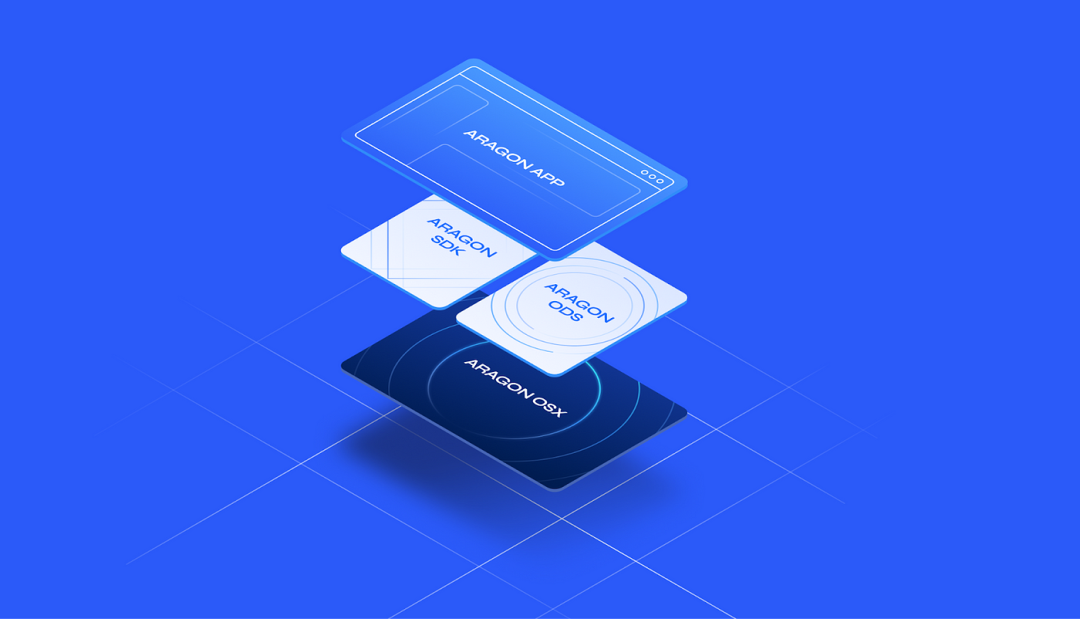
Aragon Stack
Aragon Data Analysis
Overview
In the nearly six years since its inception, over 7,000 DAOs have been built using Aragon. These DAOs collectively manage assets worth approximately $12 billion (including stETH), have proposed around 23,000 proposals, and have received over 45,000 votes from more than 6,000 voters, averaging about 7 votes per person.
While the raw data may not immediately convey the impact, in the following sections, we will delve into each specific subcategory, uncovering the development journey of Aragon and providing insights into its future prospects.
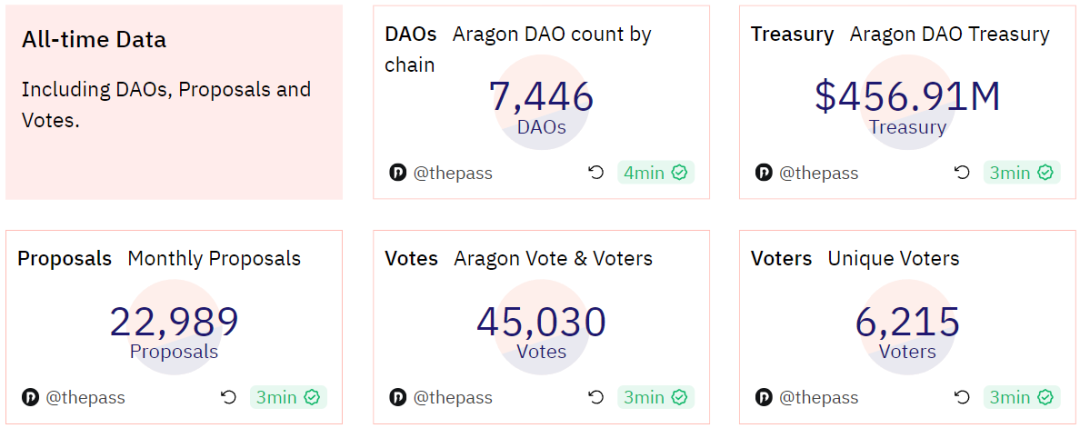
Aragon Data Overview
DAOs
Taking a different perspective on the specific number of DAOs on different blockchains, it is evident that as an early-established project, Aragon was the preferred framework for building DAOs on Ethereum before 2020. However, starting from June 2020, the gas fees on Ethereum forced many DAOs to migrate to alternative blockchains or adopt off-chain governance solutions like Snapshot.

Monthly Aragon DAOs Created on Ethereum (by version)
In September 2021, Aragon expanded to Polygon, and the number of deployed DAOs quickly surpassed Ethereum. This can be seen as an indicator of builders adopting layer 2 solutions within their communities. The new Aragon tech stack, App and OSx, was launched on Polygon at the end of March 2023. This significantly increased the accessibility of DAOs for developers worldwide. It is worth noting that when deployed on Polygon, the cost of creating proposals is as low as 5 cents or even less. Aragon has been actively expanding its influence to other Layer 2 ecosystems, including deployment on Base in August 2023.
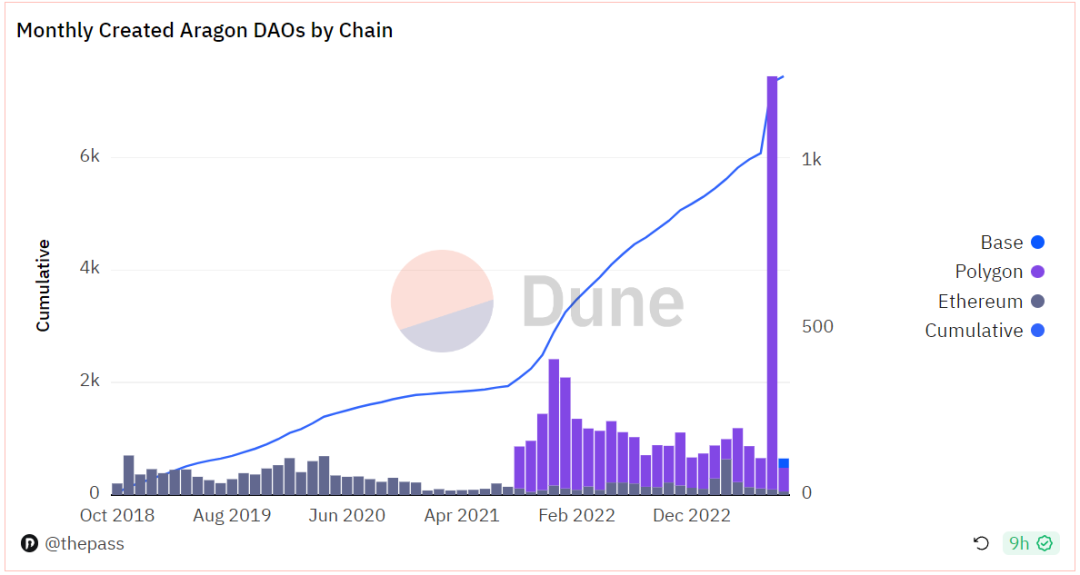
Aragon DAOs Created Monthly by Chain
Considering Aragon’s product iteration, since the release of the new tech stack in March 2023, Aragon App has quickly surpassed the old tech stack as the preferred platform for creating new DAOs. It is worth noting that the number of DAO creations has been increasing against the market downturn.

Monthly Aragon DAOs Created (by version)
A DAO that proposes at least one proposal per month is defined as an active DAO. It is clear that the number of active DAOs on Ethereum has not experienced a significant decline after June 2020, which is different from the significant decline in newly established DAOs. In addition, the number of active DAOs on Polygon is at a similar level to Ethereum. This may indicate that a considerable portion of the newly created DAOs on Polygon may be limited in activity in the future.
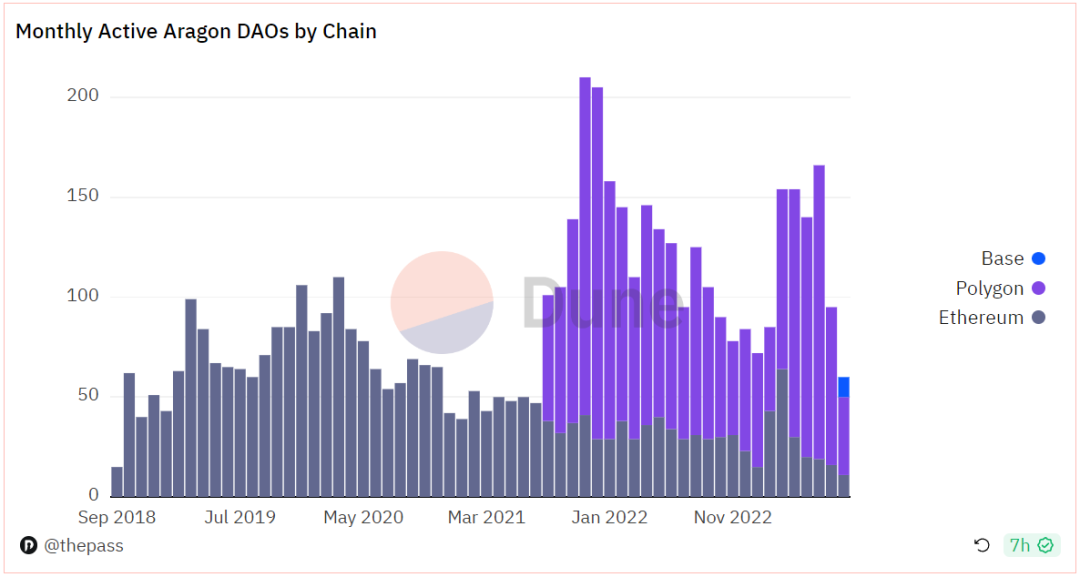
Monthly Active Aragon DAOs (by chain)
Proposals
The number of proposals and active DAOs on different chains shows a similar pattern of variation. On Ethereum, since the birth of Aragon, the number of proposals per month has been steadily increasing until it reached a peak of about 800 in June 2020, and then began to decline.
Since then, in September 2021, Polygon took the lead, and the monthly proposal volume remained around 500 for the entire year of 2022, but it has shown a downward trend since 2023.
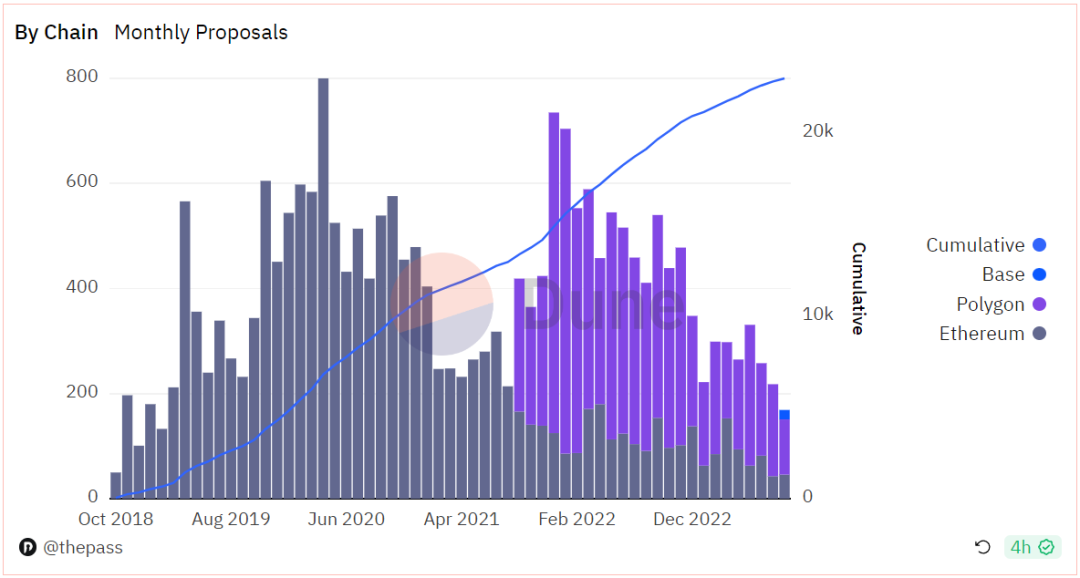
Monthly Proposal Chains
Since the launch of the new tech stack in March 2023, the proposal activity of the previous version of the Aragon client has gradually transitioned to Aragon App, currently maintaining around 200 proposals per month.

List of monthly proposals by version
When DAOs are grouped by the number of proposals, it is worth noting that two-thirds of DAOs have never initiated a proposal. Among the proposed DAOs, the majority have created fewer than four DAOs. This may be due to the current market downturn, with many DAOs experimenting with Aragon’s new technology stack; however, the actual demand for decision-making may not be as widespread.

DAO distribution of Aragon proposals
Number of votes
The number of votes and the number of voters can reflect the level of governance activity within a DAO. These two indicators show similar trends in terms of the number of proposals. On Ethereum, the number of votes and voters experienced continuous growth, followed by a gradual decrease, and finally stabilized at a steady level.
Currently, Aragon has approximately 500 monthly votes and around 200 voters. Compared to other governance tools such as Snapshot or Tally, Aragon still has a certain gap in terms of user and activity numbers.
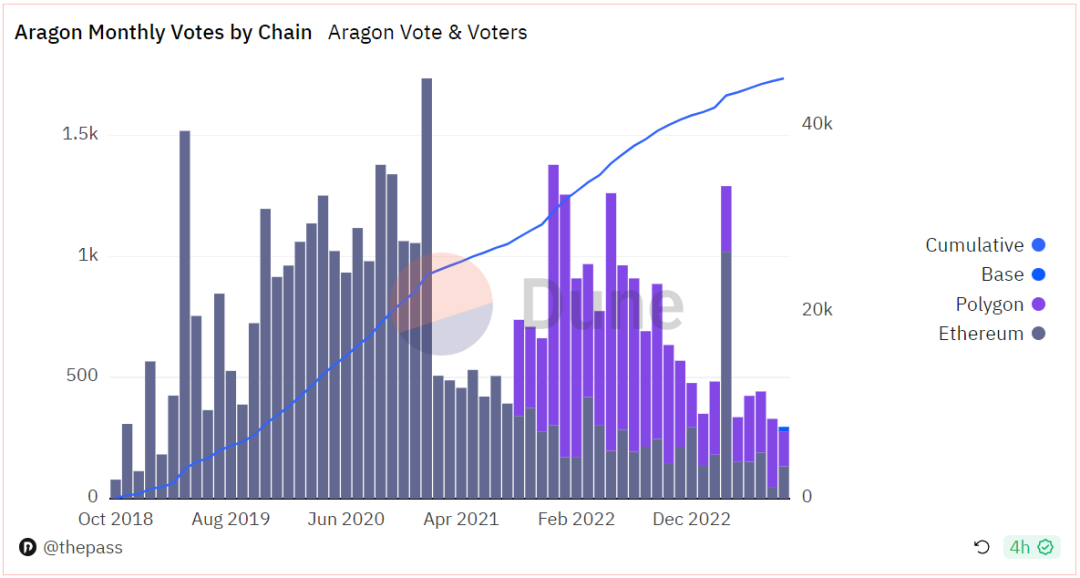
Aragon monthly on-chain voting

Aragon monthly on-chain voters
Fortunately, Aragon chooses to move away from a simple proposal voting framework and adopts a more innovative approach. Governance within a DAO is a complex framework that requires a more complex and modular structure. Some DAOs need to track reputation and participation, others require strong incentive structures, and still, others need powerful debating and resolution tools.
The diversity of DAOs has driven the need for more modular DAO architectures that are interoperable with the best DAO tooling solutions, so that DAOs can choose according to their own needs. Therefore, Aragon has developed a new technology stack to address these needs and challenges. In Aragon OSx, DAOs can flexibly utilize plugins to add or remove any custom functionalities, including governance, asset management, membership handling, etc.
Treasury
As expected, the majority of DAO treasuries on Aragon are concentrated on Ethereum. The treasury size has steadily accumulated since 2018, surged during the 2020 DeFi summer, and reached its peak in November 2021, exceeding $1.7 billion. Following the bear market, the treasury size gradually decreased and stabilized at around $500 million.

Aragon Treasury by Chain
Among the DAOs created using the Aragon client on Ethereum, Lido and Aragon itself have the largest treasuries, accounting for over 80% of the total treasury. They are followed by API3, Altered State Machine, and Decentraland, representing projects in the infrastructure, NFT, and GameFi domains, respectively. This highlights the diversity of projects using Aragon.

Aragon Treasury on Ethereum
The newly launched Aragon App is still in its early stages, with limited mainstream protocol deployment or migration. Leading the way are the Aragon Association and Eagle Ops, both of which are sub-DAOs established by Aragon to support protocol development.

Distribution of Aragon Client and Application Libraries
Summary
Aragon is an ambitious cryptocurrency project. As one of the oldest frameworks established for DAOs, Aragon has witnessed explosive growth in the field of DAO and faces challenges when competing with other more convenient and simple tools. Nevertheless, Aragon remains steadfast in pushing the boundaries of DAO exploration.
Cryptocurrency analysts often see Aragon as an experiment in the field of public management and governance, eventually forming a near-perfect governance system. One day, it may become a suitable foundation for a new generation of public order.
References
https://dune.com/theLianGuaiss/aragon-overview
https://aragon.org/manifesto
Like what you're reading? Subscribe to our top stories.
We will continue to update Gambling Chain; if you have any questions or suggestions, please contact us!